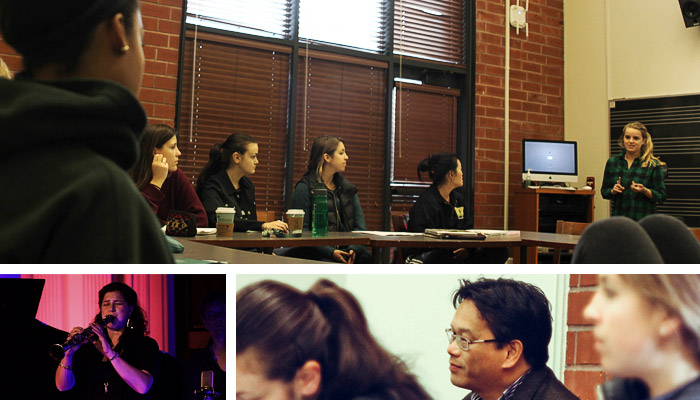
The lights dim, and soon the smooth notes of virtuoso jazz clarinetist Anat Cohen’s “As Rosas Nao Falam” fill the air. It’s a deeply soulful performance and, in the corner, Professor Hao Huang leans against the brick wall, his eyes alight with joy at what he’s witnessing.
He’s not standing in a jazz club or concert hall, however. Huang is in the Performing Arts Center of Scripps College, watching one of his Jazz Bluelines students share both a Cohen video and the experience of seeing the artist live for the first time in New York City. When the lights go up, his class delves into the significance of Billie Holliday and reads poetry inspired by the work explored here in Core III.
Bluelines has been part of the Core Curriculum for three years, but Huang has taught versions of this class for over a decade. “It started with more of a jazz history survey focus with poetry and has integrated more coverage of women in the arts,” he says. “Even for those who have been exposed to the subject matter, the experience is immersive and illuminating. They learn to care about multidisciplinary understandings by becoming familiar with many different cultural expressions related to blues and jazz.”
“Professor Huang is the heart of this course,” says Brynne Ichiuji, a sophomore from Danville, California. “While I am grateful for the newfound knowledge and appreciation for jazz, I am even more inspired by the love for music and art he instilled in all of us. He welcomes all participation and looks for engaging discussion and input.”
The course engages in guided listening and reading poetry inspired by specific performers such as Gertrude “Ma” Rainey, Louis Armstrong, Bessie Smith, Charlie Parker, John Coltrane, and others. The result is a deep investigation into jazz and the arts that gives students a new outlook on American culture and black and feminist histories – and how they are endlessly changing.
“Core is the most ambitious interdisciplinary program that I’ve taught in, both in terms of historical coverage and engagement with contemporary issues and debates,” adds Huang. “I’ve researched feminist histories in jazz and American Studies, investigated how classic blues singers challenged popular conventions of their times, and seen how the way people in the United States changed their thoughts about swing jazz during World War II.”
Most important, while Jazz Bluelines may be the culmination of the Core experience for a handful of Scripps students, it’s also their gateway into a lifetime of appreciation of uniquely American art.
“I love all music but I wanted to have a deeper understanding of it,” says Ichiuji “I decided to start with jazz because I knew on the surface that jazz is rooted in America. By the end of Core, I felt the poems were speaking directly to me. That Billie Holiday was singing for me.
“I want to go back to Core I and try it all again. See just how much did I miss?”
Watch

